-
Countries
-
Data and Analysis
-
Special Focus
-
Crisis Responses

Contact
DTM Europe, DTMMediterranean@iom.int
Language
English
Location
Latvia
Period Covered
Jul 01 2023
Sep 30 2023
Activity
- Survey
- Flow Monitoring
This report is based on a survey of displacement patterns, needs and intentions conducted by IOM’s Displacement Tracking Matrix (DTM) in the countries included in the Regional Response Plan for Ukraine in 2023: 6 countries neighbouring Ukraine – Belarus, Hungary, Poland, Republic of Moldova, Romania and Slovakia – and other 5 countries particularly impacted by the arrivals of refugees from Ukraine since the start of the war in February 2022 – Bulgaria, Czechia, Estonia, Latvia and Lithuania. The analysis presented in this report is based on data collected between July and September 2023.
Key Findings:
- Top oblasts of origin: Khersonska (29%), Donetska (17%), Zaporizka (15%), Luhanska (7%), Dnipropetrovska (5%), Kharkivska (5%)
- Intentions to move: Latvia is a transit country for many refugees from Ukraine. The majority of respondents planned to move to another country (72%). The top 3 indicated countries were Poland, Russian Federation and Germany. Others intended to move to a different location in Ukraine (22%) or return to their place of origin in Ukraine (1%).
- Employment status: Unemployed and looking for a job (50%), retired (31%), employed (8%), unemployed and not looking for a job (5%), parental leave (2%).
- Top needs:* General information (84%), food products (22%), personal safety (3%), medicine (3%), health services (2%), long-term accommodation (2%).
- Top areas of assistance received:* food products (73%), financial support (60%), housing (35%), personal hygiene and sanitary supplies (20%), transportation (13%).
*more than one answer possible
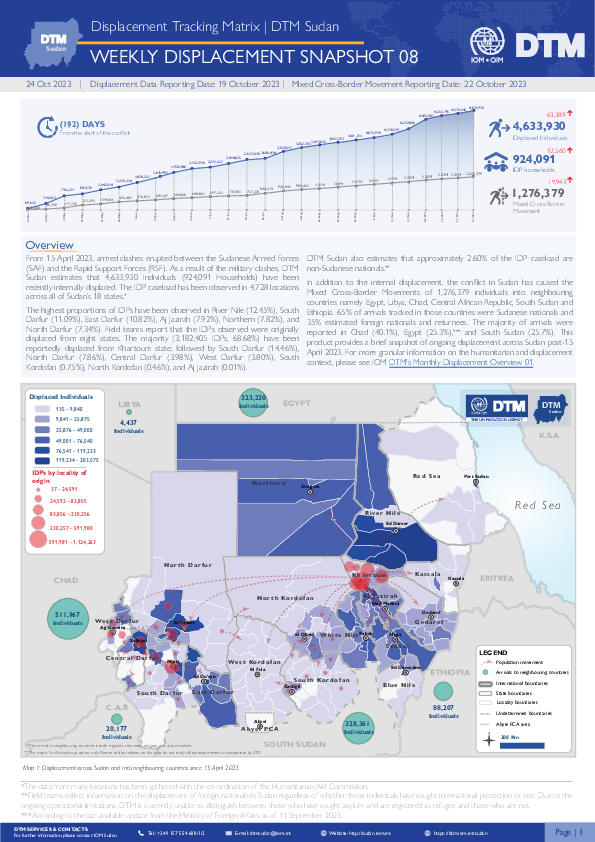
Contact
DTM Sudan, DTMSudan@iom.int
Language
English
Location
Sudan
Snapshot Date
Oct 19 2023
Activity
- Mobility Tracking
- Baseline Assessment
Overview
From 15 April 2023, armed clashes erupted between the Sudanese Armed Forces (SAF) and the Rapid Support Forces (RSF). Clashes initially took place in cities across Northern and Khartoum states, later spreading across the Darfur and Kordofan regions.
Key Findings
- DTM Sudan estimates that 4,633,930 Individuals (924,091 Households) have been recently internally displaced.
- The IDP caseload has been observed in 4,728 locations across all of Sudan’s 18 states.
- The highest proportions of IDPs have been observed in River Nile (12.45%), South Darfur (11.09%), East Darfur (10.82%), Aj Jazirah (7.92%), Northern (7.82%), and North Darfur (7.34%).
- Field teams report that the IDPs observed were originally displaced from eight states. The majority (3,182,405 IDPs, 68.68%) have been reportedly displaced from Khartoum state; followed by South Darfur (14.46%), North Darfur (7.86%), Central Darfur (3.98%), West Darfur (3.80%), South Kordofan (0.75%), North Kordofan (0.46%), and Aj Jazirah (0.01%).
- IOM DTM also reports that an estimated 1,276,379 mixed cross-border movements have been made into neighbouring countries.
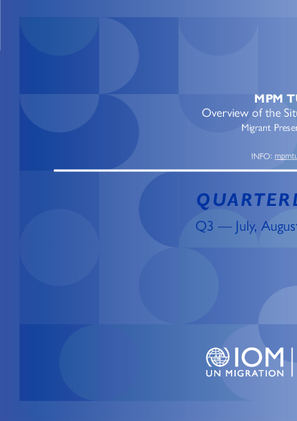
Contact
DTM Türkiye, mpmturkey@iom.int
Language
English
Location
Republic of Türkiye
Period Covered
Jul 01 2023
Sep 30 2023
Activity
- Flow Monitoring
- Migrants presence
According to the latest available figures from the Turkish Presidency of Migration Management (PMM), there are more than 4.7 million foreign nationals present in Turkish territory, 3.6 million of whom are seeking international protection. Most are Syrians (3,279,1521 individuals) who are granted temporary protection status. In addition, international protection applicants from countries including Iraq, Afghanistan, the Islamic Republic of Iran and Ukraine constitute another group of foreign nationals. According to PMM, there were 33,2462 international protection applicants present in Türkiye in 2022, published annually.
Moreover, according to United Nations High Commissioner for Refugees (UNHCR), there were 304,6973 refugees and asylum-seekers in Türkiye as of 2022. Since June 2023 the number of Syrians residing in camps has increased by 9,098.

Contact
DTM DRC, iomdrcdtm@iom.int
Language
French
Location
Democratic Republic of the Congo
Period Covered
Aug 06 2023
Aug 23 2023
Activity
- Baseline Assessment
Ce tableau de bord présente les principaux résultats de suivi des mouvements de populations dans la province de l’Ituri, à l’issue du dixième cycle d’évaluation conduit par l’unité la Matrice de suivi des déplacements (Displacement Tracking Matrix, en anglais (DTM)) de l’Organisation internationale pour les migrations (OIM). Ces évaluations ont été réalisées à travers un exercice de collecte de données conduit du 6 au 25 août, en collaboration avec l’ONG locale, Réseau d’Action pour le Développement et le Progrès Intégré (RADPI), et la Commission Nationale pour les Réfugiés (CNR). Lors du ce cycle, un total de 6 430 villages, couvrant 36 zones de santé (ZS), ont été évalués à travers des consultations avec 16 536 informateurs clés.

Contact
daibrahim@iom.int
Language
English
Location
Lebanon
Period Covered
Oct 23 2023
Oct 21 2023
Activity
- Mobility Tracking
- Baseline Assessment
Since October 8 there has been an increase in cross-border incidents between Israel and Lebanon, resulting in the displacement of people both within the South and elsewhere within the country. Since October 10, the Displacement Tracking Matrix (DTM) has been conducting the daily monitoring of population movements. The objective of the exercise is to inform preparedness and response planning.
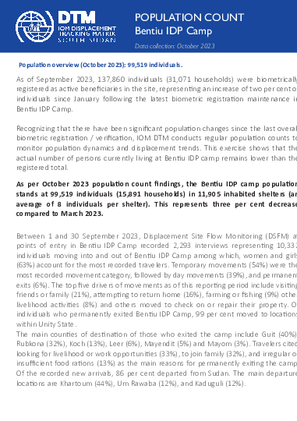
Contact
DTM South Sudan, SouthSudanDTM@iom.int
Language
English
Location
South Sudan
Period Covered
Oct 05 2023
Oct 08 2023
Activity
- Registration
- Flow Monitoring
- Mobility Tracking
- Site Assessment
As per October 2023 population count findings, the Bentiu IDP camp population stands at 99,519 individuals (15,891 households) in 11,905 inhabited shelters (an average of 8 individuals per shelter). This represents three per cent decrease compared to March 2023.
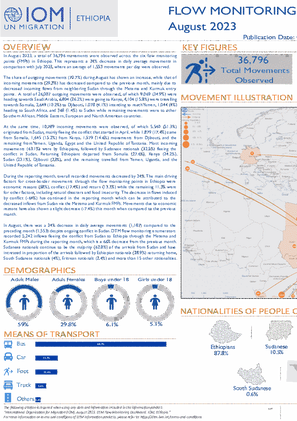
Contact
DTM Ethiopia, DTMEthiopia@iom.int
Language
English
Location
Ethiopia
Period Covered
Aug 01 2023
Aug 31 2023
Activity
- Flow Monitoring
In August 2023, a total of 36,796 movements were observed across the six flow monitoring points (FMPs) in Ethiopia. This represents a 24% decrease in daily average movements in comparison with July 2023, where an average of 1,553 movements per day were observed.
The share of outgoing movements (70.7%) during August has shown an increase, while that of incoming movements (29.3%) has decreased compared to the previous month, mainly due to decreased incoming flows from neighboring Sudan through the Metema and Kurmuk entry points. A total of 26,007 outgoing movements were observed, of which 9,069 (34.9%) were heading towards Saudi Arabia, 6,804 (26.2%) were going to Kenya, 4,104 (15.8%) were travelling towards Somalia, 2,649 (10.2%) to Djibouti, 1,078 (4.1%) intending to reach Yemen, 1,044 (4%) heading to South Africa, and 368 (1.4%) to Sudan while remaining movements were to other Southern African, Middle Eastern, European and North American countries.
At the same time, 10,789 incoming movements were observed, of which 5,540 (51.3%) originated from Sudan, mainly fleeing the conflict that started in April, while 1,879 (17.4%) came from Somalia, 1,645 (15.2%) from Kenya, 1,579 (14.6%) movements from Djibouti, and the remaining from Yemen, Uganda, Egypt and the United Republic of Tanzania. Most incoming movements (63.1%) were by Ethiopians, followed by Sudanese nationals (32.5%) fleeing the conflict in Sudan. Returning Ethiopians departed from Somalia (27.6%), Kenya (24.2%), Sudan (23.1%), Djibouti (23%), and the remaining travelled from Yemen, Uganda, and the United Republic of Tanzania.
Contact
DTM Yemen, iomyemendtm@iom.int
Location
Yemen
Activity
- Mobility Tracking
Period Covered
Oct 15 2023 -Oct 21 2023
From 1 January to 21 October 2023, IOM Yemen DTM tracked 4,767 households (HH) (28,602 Individuals) who experienced displacement at least once.
Between 15 and 21 October 2023, IOM Yemen DTM tracked 32 households (192 individuals) displaced at least once. The majority of people moved into/within the following governorates and districts:
- Ma’rib (18 HHs) – Ma’rib (10 HHs), Harib (5 HHs), Ma’rib City (3 HHs) districts. Most displacements in the governorate originated from Ma’rib and Ibb.
- Ta’iz (9 HHs) – Al Makha (5 HHs), Jabal Habashi (3 HHs), Al Maafer (1 HH) districts. Most displacements in the governorate originated from Ta’iz and Ibb.
- Al Hodeidah (3 HHs) – At Tuhayta (3 HHs) district. All displacements in the governorate were internal.
- Ma’rib (13 HHs) – Harib (10 HHs), Al Jubah (2 HHs), Raghwan (1 HH) districts.
- Ta’iz (8 HHs) – Al Maafer (4 HHs), Sabir Al Mawadim (3 HHs), Jabal Habashi (1 HH) districts.
- Ibb (5 HHs) – Al Qafr (2 HHs), Badan (2 HHs), As Sabrah (1 HH) districts.
Population Groups
Survey Methodology
Unit of Analysis Or Observation
Type of Survey or Assessment
Keywords
Geographical Scope
Administrative boundaries with available data
The current dataset covers the following administrative boundaries
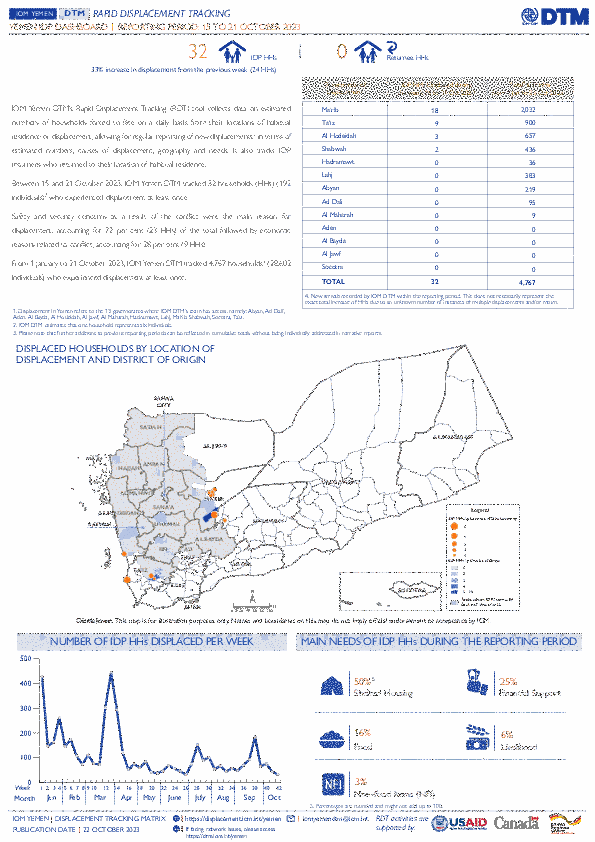
Contact
DTM Yemen, iomyemendtm@iom.int
Language
English
Location
Yemen
Period Covered
Oct 15 2023
Oct 21 2023
Activity
- Rapid Emergency Registration
- Mobility Tracking
IOM Yemen DTM’s Rapid Displacement Tracking (RDT) tool collects data on estimated numbers of households forced to flee on a daily basis from their locations of origin or displacement, allowing for regular reporting of new displacements in terms of estimated numbers, geography, and needs. It also tracks returnees who returned to their location of origin.
From 1 January to 21 October 2023, IOM Yemen DTM tracked 4,767 households (HH) (28,602 Individuals) who experienced displacement at least once.
Between 15 and 21 October 2023, IOM Yemen DTM tracked 32 households (192 individuals) displaced at least once. The majority of people moved into/within the following governorates and districts:
- Ma’rib (18 HHs) – Ma’rib (10 HHs), Harib (5 HHs), Ma’rib City (3 HHs) districts. Most displacements in the governorate originated from Ma’rib and Ibb.
- Ta’iz (9 HHs) – Al Makha (5 HHs), Jabal Habashi (3 HHs), Al Maafer (1 HH) districts. Most displacements in the governorate originated from Ta’iz and Ibb.
- Al Hodeidah (3 HHs) – At Tuhayta (3 HHs) district. All displacements in the governorate were internal.
The majority of people moved from the following governorates and districts:
- Ma’rib (13 HHs) – Harib (10 HHs), Al Jubah (2 HHs), Raghwan (1 HH) districts.
- Ta’iz (8 HHs) – Al Maafer (4 HHs), Sabir Al Mawadim (3 HHs), Jabal Habashi (1 HH) districts.
- Ibb (5 HHs) – Al Qafr (2 HHs), Badan (2 HHs), As Sabrah (1 HH) districts.

Contact
dtmpakistan@iom.int
Language
English
Location
Pakistan
Period Covered
May 01 2023
Jun 30 2023
Activity
- Survey
- Mobility Tracking
- Site Assessment
From June to October 2022, storms and heavy monsoon rains in Pakistan caused widespread flooding and landslides across the country. As of 18 November 2022, according to the National Disaster Management Authority (NDMA), up to 33 million people have been affected by the floods and a total of 90 districts have been labelled by the Government of Pakistan as ‘calamity-hit’.
Between May and June 2023, IOM implemented a third round of the CNI to provide partners with timely information on the displacement situation, the multisectoral needs of the affected population as well as the recovery needs at the settlement level. For this round, IOM implemented the CNI in nine districts of Balochistan. The CNI was conducted in 3,261 flood-affected settlements or settlements that hosted temporary displaced persons (TDPs) across the nine targeted districts.
